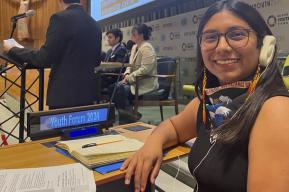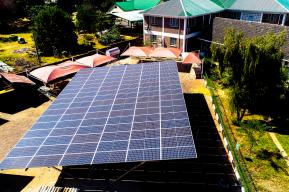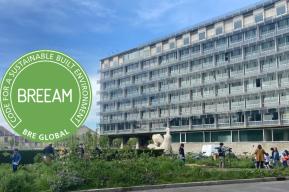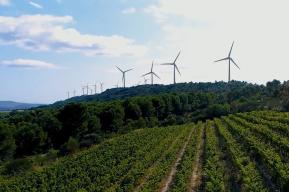News
UNESCO has taken major steps in its environmental management
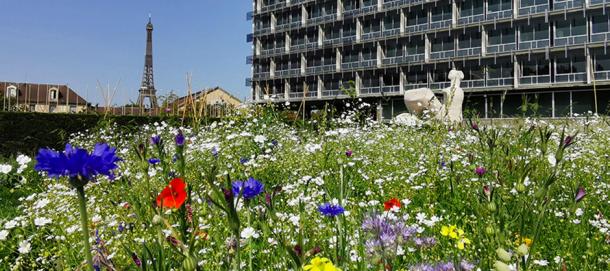
A lot of progress have been spurred during the three years of Strategic Transformation, and this is a new milestone in the process which has helped UNESCO to set up and implement an Environmental Management System (EMS) to track and reduce its carbon emissions, waste generation, and water use.
UNESCO’s Environmental Sustainability and Management Policy was published in June 2021. This policy is a major improvement in the Organization providing a concrete and practical framework to integrate sustainability practices into UNESCO’s activities. It provides cross-cutting policies to reduce the Organization’s carbon footprint. The overall aim is to minimize any negative impact on the environment by UNESCO’s operations worldwide, and contribute positively to protecting the environment and communities in which its operate. Access the policy in English or French.
UNESCO’s Strategic Transformation advocated for strong environmental commitments
- Implementing an internal carbon tax on air travel –to finance carbon offsetting initiatives and invest in emission-reduction measure across the long term;
- Creating a biodiversity and vegetable garden at UNESCO headquarters in partnership with the French National Commission that features information about the seasonal fruits and vegetables, pollination, and agricultural methods. A parallel effort with the Portuguese company Noocity created a sustainable vegetable, fruits, and herbs garden at Headquarters that distributes fresh food to subscribed staff members;
- Launching a ‘zero plastic’ policy and commitment to reduce food waste that is upheld by UNESCO’s new catering service SERENEST;
- Switching to electricity supply from 100% renewable sources at HQ;
- Entering a collaboration with UNEP to introduce environmentally conscious practices into digital working via the “Virtual Meetings” project;
- Gradually replacing of the HQ fleet with electric vehicles (so far 1 electric, 1 hybrid car; acquisition of additional electric vehicle in discussion); and
- A variety of measures and activities to engage staff and enhance their environmental awareness, such as a corporate subscription to the bike-sharing system ‘Vélib’ in Paris or a campaign to participate in World Cleanup Day.
Achieving Climate Neutrality
In 2020, the UN Greening the Blue report scored UNESCO as “climate neutral” because it had measured and offset all of its 2019 carbon emissions caused by its facilities and official travel
through the purchase of UN-Certified Emission Reduction (CER) credits. Solidifying the organization’s commitment to greener practices, UNESCO has pledged to cut carbon emissions by 45% by 2030 (compared to 2010) to further reduce its carbon footprint, in line with the goals of the Paris Agreement.
Since 2020, UNESCO is also offsetting all emissions related to its HQ publications and printing service, via a hydropower project near Virunga National Park in the Democratic Republic of Congo, a UNESCO World Heritage site.
Actions at Headquarters and Field Offices
Since January 2021, UNESCO Headquarters has been 100% powered by renewable energy via provider Planète OUI.
In Zimbabwe, UNESCO’s regional office for Southern Africa in Harare has taken major strides in environmental sustainability that have engaged staff in the development and design processes. Since 2018, the Office eliminated single-use plastic waste and gone paperless where possible. As well, they replaced their lighting system to a greener LED system and used a sticker system to encourage staff to be more mindful about electricity use and turn lights off when leaving a room.
In 2019, the Office established the Green Plan Committee to discuss ways to improve sustainability at regional offices. The Office released a ten-step plan for UNESCO offices in Southern Africa and also have put together a carbon offsetting strategy to dramatically reduce their environmental footprint.
Ya Su, administrative office from UNESCO Harare, says that the office is implementing fully solar powered office energy systems.

After an internal audit of environmental practices and areas of improvement, the UNESCO Institute for Lifelong Learning (UIL) in Hamburg, Germany, created a Greening Action Plan with quantifiable targets and indicators across Travel, Events, Facilities Management, and Publications to improve its sustainable practices. UNESCO Bangkok, Harare, and the UIL demonstrate the initiative and power of staff to drive internal change across the field.
Actions across UNESCO have not gone unnoticed. In their most recent “Review of mainstreaming environmental sustainability across organizations of the United Nations system,” the Joint Inspection Unit highlighted how UNESCO’s Strategic Transformation and concrete workplace programs have helped make the organization more sustainable.
*****
For further information, please visit our Environment Management website


